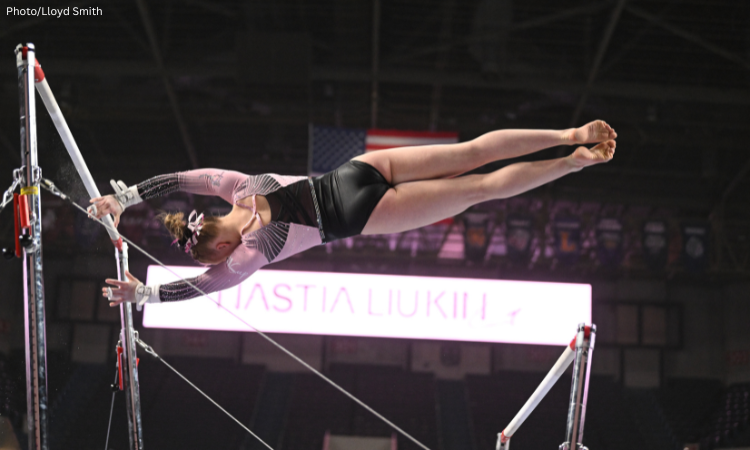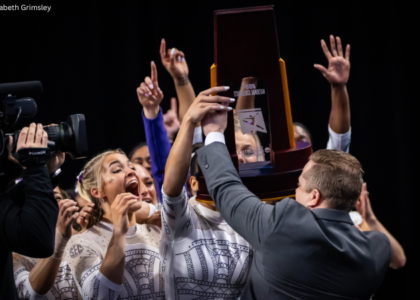If you didn’t grow up doing gymnastics in the United States, a lot of the rules and formatting surrounding the USA Gymnastics Developmental Program can be pretty confusing. With the club season now underway and Nastia Liukin Cup qualifying in full swing, we sat down to answer some frequently asked questions to give you all the information you need to understand as you follow along.
How does level 10 nationals work?
The top level 10 athletes from across the country have to qualify to nationals by performing well at their state and regional championships. Athletes are divided into roughly equal-sized age groups and must finish in a top percentage or reach a qualifying score (for example, 35.000 in the all-around) at their state meet to qualify for the regional championships. Each region sets their own criteria for qualify to regionals.
To qualify for level 10 nationals, the top seven all-arounders in each region in each age group are automatically named to their region’s national team, with the eighth and ninth place finishers named as alternates. All athletes must reach a minimum score of 35.000 in the all-around to make the team. If a region cannot fill a full team in each age group with the minimum score, athletes from other larger or more competitive regions can fill these positions. However, if this is the case, that region’s team becomes an “All Star” team, rather than competing for the specific region.
Regions can also qualify 22 additional athletes to compete in the All Star session at nationals. Athletes in this session compete as individuals, not as a part of any team. Each region can award two additional all-around spots for the All Star session, as well as five spots per event. This is how event specialists can qualify, but if they qualify through one of the event spots, they can still compete on multiple events or in the all-around.
What are the age groups and how are they determined?
As of 2023 for both regionals and nationals, there were 12 different age groups. These age groups are determined by the athletes’ birthdays. For instance, Junior A, the youngest age group, consists of athletes born January 26, 2009, and later, while Senior F, the oldest age group, consists of athletes who have birthdays on January 28, 2005, or earlier. The dates change each year to make the age groups all equally sized. If you are interested in the full list, you can click here.
How is level 10 different from college? Elite?
NCAA rules are essentially level 10 rules, with some key modifications. The biggest differences are a change in some of the difficulty values. For example, a double full dismount off the beam is a D in NCAA and a C in level 10, increasing its difficulty value. On the flipside, a front pike on floor is an A in NCAA but a B in level 10, devaluing the skill for college competition.
Another key difference is the special requirements. In level 10 it’s a five-tenth deduction if one is missing, and in NCAA it’s only two tenths. In level 10, routines start from a 9.5 maximum score before bonus is awarded, and in college competition, routines start at a 9.4. However, there are more opportunities to earn bonus in NCAA compared to level 10. Especially difficult routines have the capacity to earn an additional one tenth above a 10.0 for their start value (essentially starting at a 10.1) in level 10, whereas NCAA routines can’t earn a start value advantage for the additional difficulty.
Execution deductions in level 10 and NCAA are the same, although culturally NCAA judges have a reputation for taking smaller execution deductions than level 10 judges, even though NCAA judges evaluate level 10 and NCAA routines. For more on these unspoken differences, check out our past Judge’s Inquiry on level 10 routines.
Elite scoring and rules are completely different, as they no longer use a 10.0 system and have an open-ended scoring system. In elite, a gymnast’s score is the sum of their execution (E) score and difficulty (D) score. Execution scores start from a 10.0 and deduct anywhere from one tenth to one point for execution errors, which makes elite E scores much lower than NCAA scores. The D score is calculated by adding up the point value of the eight most difficult skills in the routine, plus the special requirements and any combination bonus. D scores usually range between a 4.0 to 6.0, with a D score over 6.0 being very rare (unless you’re Simone Biles). Judges add the D score to the E score to get the final score, which is almost always above a 10.0 unless the routine went very badly.
What does being a level 10 even mean?
Level 10 is the highest level in USAG’s Developmental Program before elite. There is really a small percentage of athletes that choose to go the elite route, and usually this happens early in their career (this is why you see really young elites in the junior division who move up to the senior level when they are 16). A lot of gymnasts compete at level 10 for a couple of years before going to college, but this is the “last step” in USAG before either going on the elite route or competing until being a senior in high school and going to the NCAA.
What are the different DP regions and what states are in each one?
There are eight different regions that compete at the level 10 Developmental Program national championships:
- Region 1: Arizona, California (broken up into Northern and Southern regions), Utah, and Nevada
- Region 2: Alaska, Hawaii, Idaho, Montana, Oregon, and Washington
- Region 3: Arkansas, Colorado, Kansas, New Mexico, Oklahoma, Texas, and Wyoming
- Region 4: Iowa, Minnesota, Missouri, Nebraska, North Dakota, South Dakota, and Wisconsin
- Region 5: Kentucky, Illinois, Indiana, Michigan, and Ohio
- Region 6: Connecticut, Maine, Massachusetts, New Hampshire, New York, Rhode Island, and Vermont
- Region 7: Delaware, Maryland, New Jersey, Pennsylvania, Virginia, and West Virginia
- Region 8: Alabama, Florida, Georgia, Louisiana, Mississippi, North Carolina, South Carolina, and Tennessee
The top level 10 gymnasts from each region in each age group compete together on a team against the other regions for team awards.
What do the different colored regions at nationals mean?
The different colors at regions at nationals are essentially just assigning a color to that specific region. There is no specified reasoning behind the colors that are assigned and who they are assigned to; they are merely just there to break it up amongst the eight teams. Every few years, a regions color will change to mix things up.
What does the level 10 postseason look like? How do you qualify for each step?
There are several steps to getting to actually compete in the level 10 postseason, and this qualification process looks different for a lot of people. Generally speaking, most athletes compete all-around in USAG, so for someone who is competing on all four events, the first step is to qualify for your state’s championship. To qualify for this meet, you would need to score a 33.000 in the all-around, which averages to an 8.250 on every event. This score also has to be obtained in your state. So, if you had a really great meet in Florida but you’re from Pennsylvania trying to qualify to state, this score wouldn’t really be too helpful.
At state, if you score a 34.000 all-around, an average of an 8.500 on each event, you will qualify for regionals. The last step to actually qualifying for nationals is to compete at regionals and place within the top seven in the all-around in your age group. The next two athletes, the ones who placed eighth and ninth, are usually the alternates for their region, or in some circumstances if another region doesn’t have enough athletes to compete at nationals, they will compete at nationals but for that specific region on the All Star team.
This is the case for all-around athletes, but there is a slightly different procedure for individual event specialists. If you are an IES, to get to state, you have to score an 8.900 on your event(s) to qualify. From state to regionals, you have to score a 9.200 to qualify. Unfortunately, as an IES, you can only qualify to the All Star session at nationals but not the regional team.
One other way to get to the postseason for level 10 is by petitioning. This usually happens if the athlete was sick or for some reason could not get to a competition but has the scores to actually compete at the postseason meet.
What is the Nastia Liukin Cup and how does it factor into the season/postseason?
The best way to describe the Nastia Liukin Cup is like a mini, ultra-pink nationals. This meet has 25 qualifying meets around the country, which are usually the bigger invitationals of the year, like the Metroplex Challenge in Fort Worth, Texas, or the Brestyan’s Invitational in Boston (for a full list of qualifying meets for 2024, click here). The actual score you get at the qualifying invitational doesn’t matter because to qualify for the Nastia Liukin Cup, you have to be the highest scoring level 10 junior of the entire invitational or the highest scoring senior. The juniors are ages 16 and under, and the seniors are ages 17 and older.
The Nastia Liukin Cup does not specifically factor into the season/postseason, meaning it’s not a “step” to get to nationals. However, this has grown to be a high-profile meet and can definitely get the gymnasts that qualify more attention, specifically from college coaches.
How many meets do gymnasts typically compete in during the regular season?
The season for level 10 athletes looks very different than that of an NCAA athlete. For a college gymnast, there are usually 11 to 13 meets in the regular season before the postseason, which could include anywhere from one to six more. For example, a team like Oklahoma that has consistently made it all the way through postseason will compete a total of 16 times in the span of less than four months. For athletes in the Developmental Program, level 10s will most likely have around half this amount of competitions, including the postseason, which looks more similar to elite where they compete only a few of times a year.
A level 10 will probably compete five to six meets before state, then state, regionals, and if they qualify, nationals. Another difference comparing USAG and NCAA is the length of the meet season. NCAA spans from the first week of January to postseason concluding in the second or third week of April at the most. In USAG, the meet season can begin as early as late November and conclude the year with DP nationals the second week of May. So not only are there typically fewer competitions, there is a substantially longer time athletes have to be competition ready and healthy.
READ THIS NEXT: How to Watch College Gymnastics in 2024
Article by Rhiannon Franck and Julianna Roland




